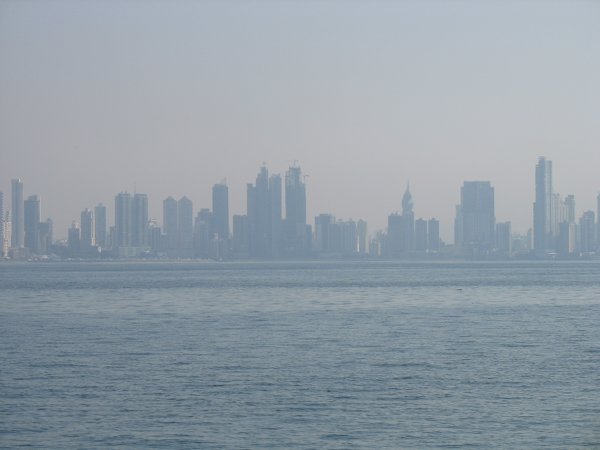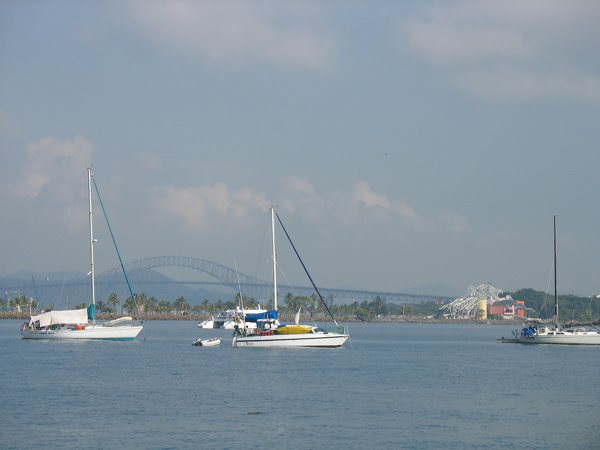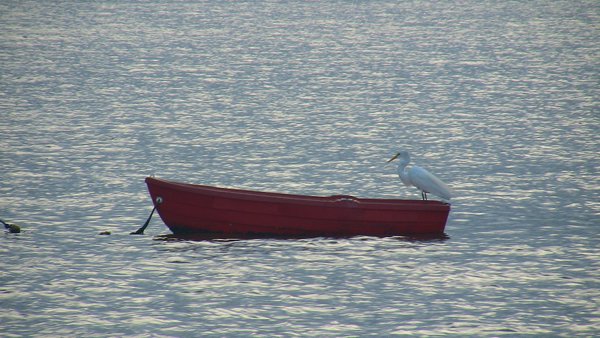|
Our transit of
the Panama Canal was scheduled for 22-23 May.
We had decided to employ four Panamanian line handlers who were provided by Tito
Ng. Our taxi driver/tourist guide/body guard, Francisco, dropped them off at
lunch time. When we started to bring in our anchor, we knew that we had a
problem. Usually, when I put the boat in gear, it starts to move forward, but
this time, we just sat there. A little more throttle and we moved slowly. Now,
we had noticed in the last couple of days before we left that barnacles had
started to appear at the water line. It turned out that our ten month old
anti-foul was no match for the little critters and Bob later found that the
whole of the bottom had been infested in the last week that we were there. They
had even grown on the anchor chain so that the links were full of barnacles in
some sections.
We had to go
around to “The Flats” to anchor and wait for our transit adviser to arrive. Bob
and a couple of our line handlers went in with scrapers and attacked the
barnacles near the water line. They really needed half the day to make any
significant difference. It turned out that the barnacles made little difference
to our progress on Sunday because we did not have to motor quickly. There were
five yachts to go through and we went first with an Australian yacht from
Freemantle called “Spice”. We were to go in a lock behind a dry-bulk carrier
called “Southern Fighter”. She was running late but our adviser, Carlos, had us
under way in plenty of time to trundle along at a couple of knots and get
ourselves up near the lock and rafted up to “Spice”.
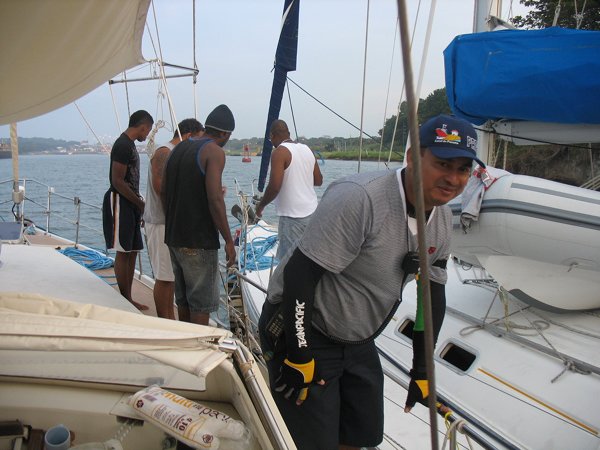
Carlos supervises as we raft up to "Spice".
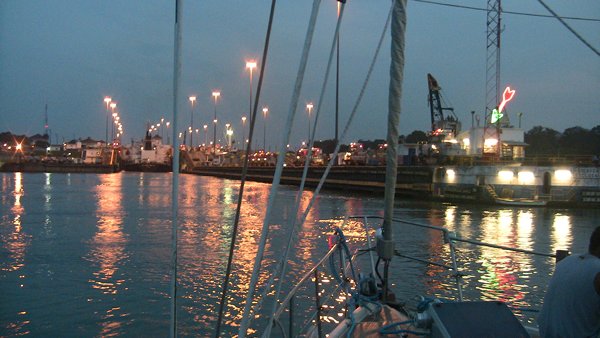
Approaching the Gatun Locks. Note the large arrow showing which lock
to enter.
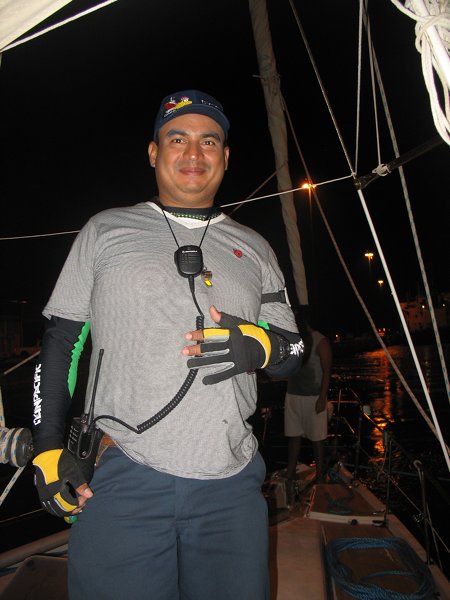
Carlos is pleased with the way things are going.
At the Gatun
Locks, boats from the Atlantic side are lifted through three locks to the level
of the Gatun
Lake. It was here that we
really appreciated having experienced line handlers. The water enters at an
incredible rate and swirls around as it rises. The line handlers have to take up
the slack in the ropes that hold us to the walls and keep the yachts in the
centre of the lock. It was good to be able to relax and watch the proceedings
knowing that we were in good hands (literally). Carlos did a wonderful job at
supervising the whole process and his calm but authoritative manner added to the
relaxed atmosphere. I commented to Bob that this must be what it is like to have
a crewed yacht – all we had to do was steer. Once we had reached Gatun Lake, it was an easy trip to a buoy where
we were all rafted up for the night.
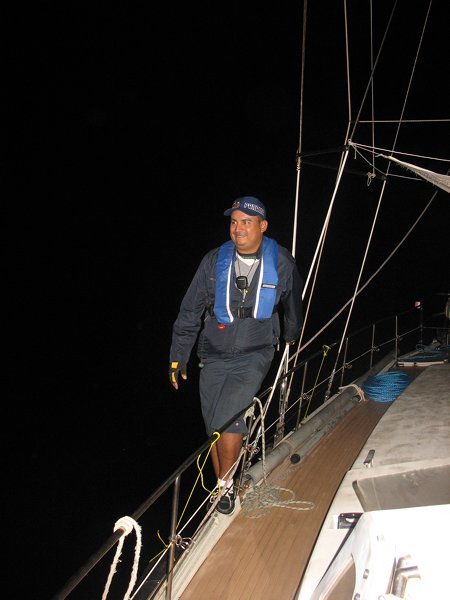
Carlos is ready to be taken off by the pilot
boat. Tricky night time manoeuvre.
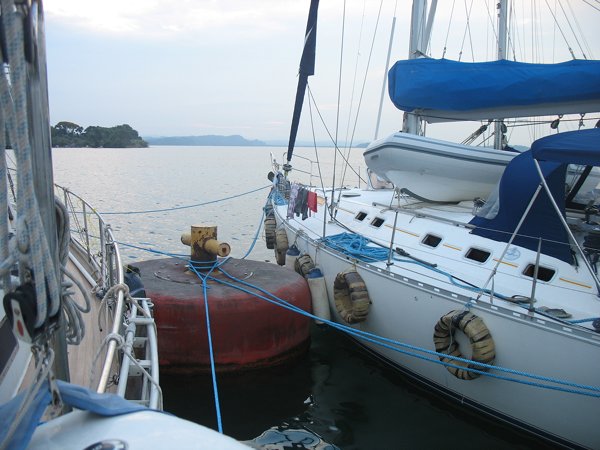
Rafted to the buoy in Gatun
Lake.

Meza was our transit adviser for the Gatun
Lake crossing and the Miraflores Locks.
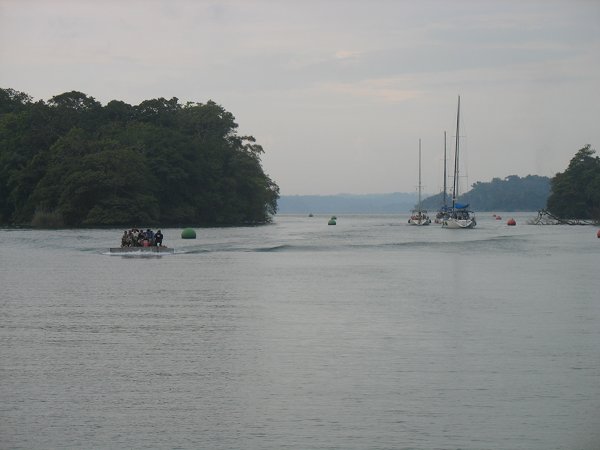
Entering the Banana Channel, a short cut for
yachts.
The alarm was
set for 0530 the next morning as our adviser for the next day would be arriving
at 0630. Meza, our adviser for the trip across Gatun Lake and through the Miraflores Locks,
arrived just as we finished breakfast.
He wanted to know our best speed and we explained the growth of barnacles
that was slowing us down. We had to travel across Gatun Lake and through The Cut, about 40nm, and
be there by 1130. As the morning progressed, we were left further behind the
other yachts. We were supposed to be rafted up to “Spice” again through the
Miraflores Locks. Meza wanted to get to Gamboa at the entrance to The Cut by
1100. As we pushed harder the temperature gauge began to rise alarmingly. Bob
thought that we might be able to hold the temperature if he kept taking off hot
water. The engine has a heat exchange where sea water coming in cools the fresh
water that then goes into the hot water system. This did seem to make a small
difference so he spent quite some time filling buckets of scalding water that
was put back into our water tank when it cooled a little.
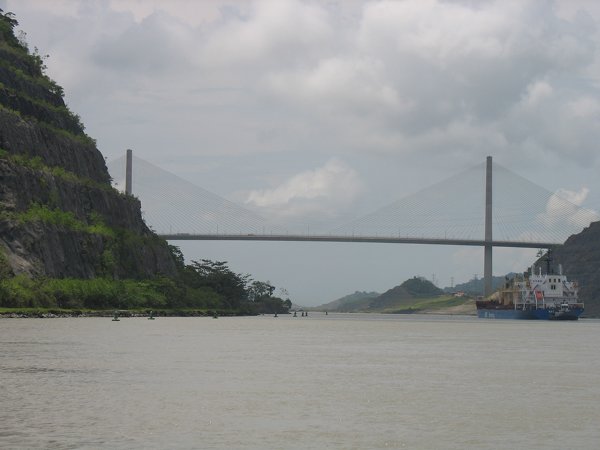
Freedom Bridge with the original cuts visible on either
side.
When it was
obvious that we would not make it to the lock in time, Meza phoned and,
fortunately, arranged for us to go into the locks with a ship called “BBC
Pluto”. We were fortunate because this was the last ship for the day that we
could go with. All of the rest were either too long or were carrying “dangerous”
cargo. When we arrived at the locks, we had to wait while they maneuvered
“Pluto”, then we had to hurry ahead and go into the lock as we were going to be
in front. We could see the other yachts in the lock ahead of us so we were not
that far behind but enough to make a difference. We had to tie alongside and
wait for the shore line handlers to come back from handling the other yachts.
“Pluto” was attached to the electric mules that would keep her in place while we
waited. When the line handlers did arrive, Meza had them moving very smartly
because we had the ship behind us.
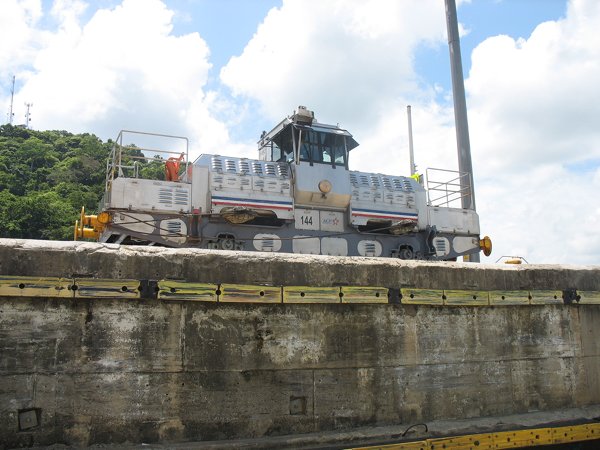
Electric mule for handling ships.
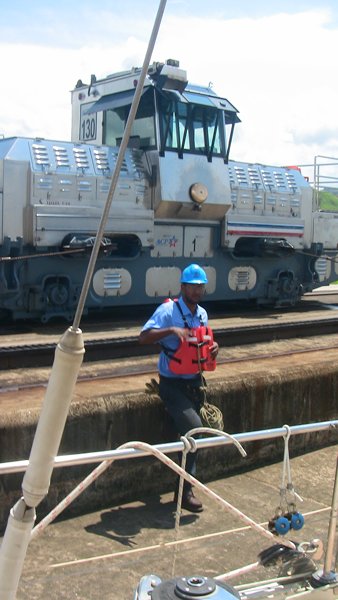
Human line handler for yachts. An electric mule is in the
background.
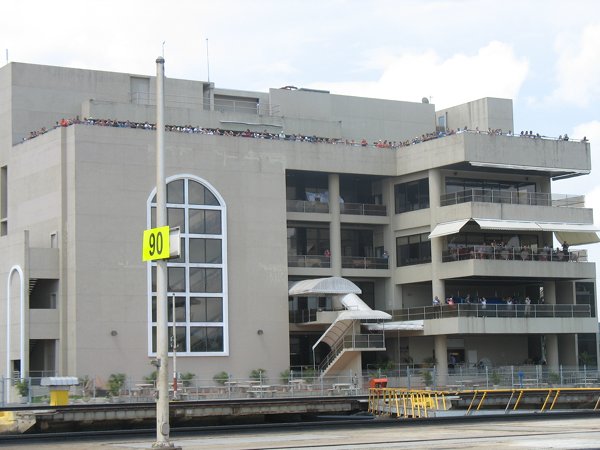
Visitor centre at Miraflores Lock. Notice the crowds on the top
balcony.
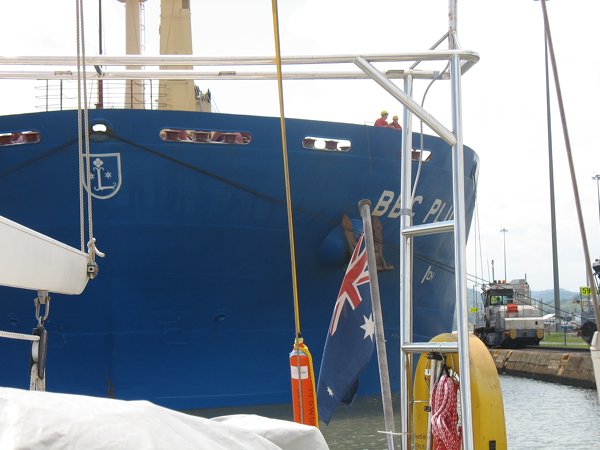
"Pluto" was not far behind.
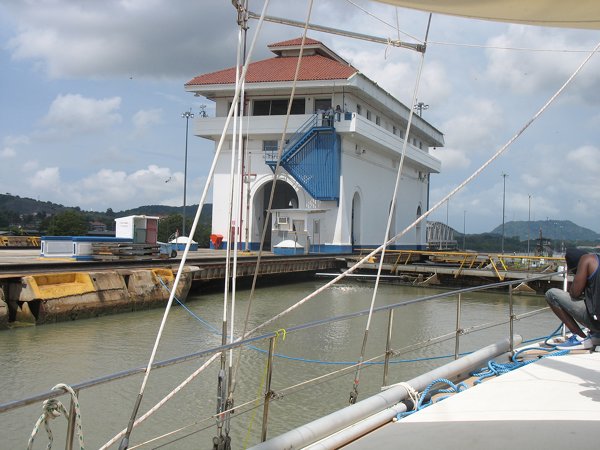
Our blue port bow line is clearly visible. Control room at
Miraflores Lock.
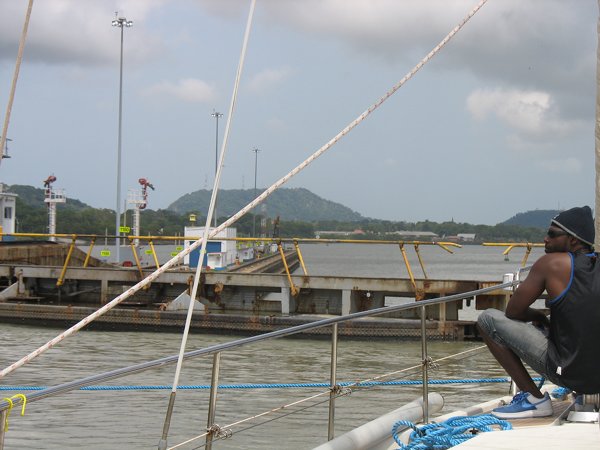
Waiting for the water to be drained.
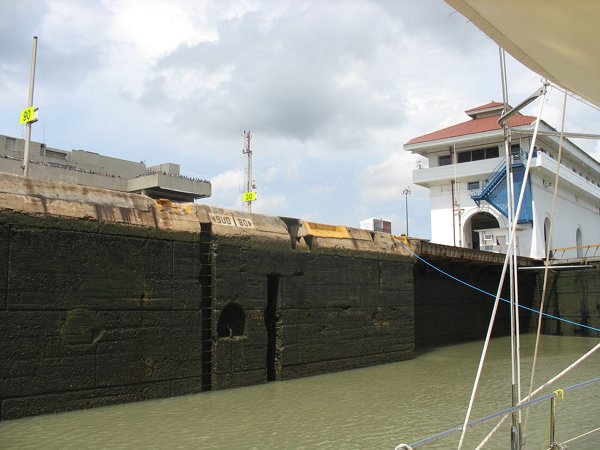
Alternate view of the control room and visitor centre. We had
seen a documentary of the building of the canal but it is not until you are in
it that you really appreciate what an incedible effort was put in by the
builders and designers so many years ago. They did it without the technology
that we have today.
The visitor
centre was packed with spectators watching the boats go through the locks. Here,
boats coming from the Atlantic are lowered to the level of the Pacific. The
water going out does not swirl like the water coming in but the line handlers
still have to be alert and let out rope as we go down. When the gates open,
there is a certain amount of current. After we left the locks, it was an easy
trip towards the Bridge of the Americas and the Pacific. Meza was
also calm in his manner and made a potentially stressful situation a very
pleasant and memorable one. When the pilot boat came out to collect Meza, we
didn’t even have to slow down. These people who move on and off the ships and
yachts as they continue on their way without slowing would all make excellent
stunt men. We would like to thank our advisers and line handlers for making our
transit so pleasant.
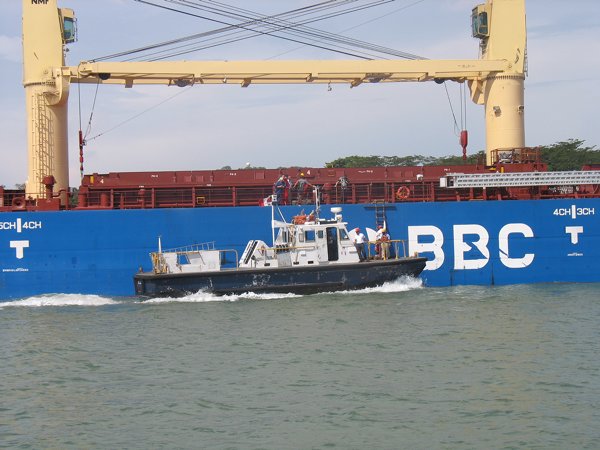
Removing handlers from "BBC Pluto".
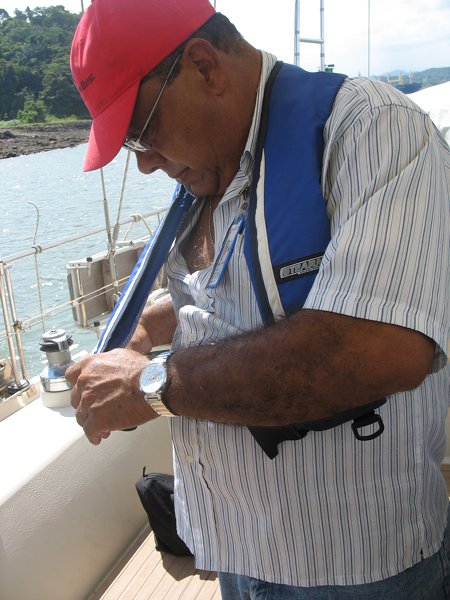
Meza preparing to leave.

Pilot boat arrives.
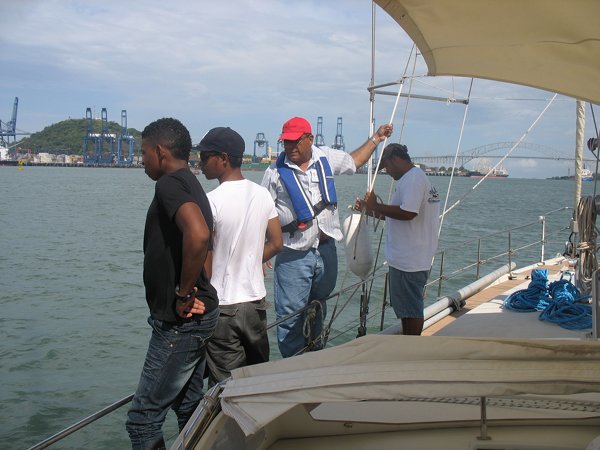
Waiting for the right moment.
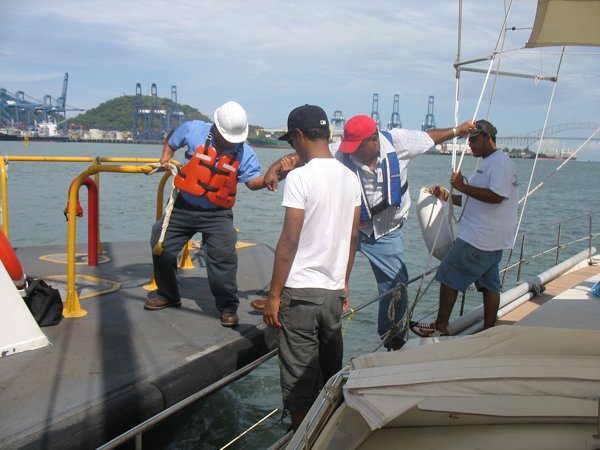
And Meza is away. We didn't even slow
down.
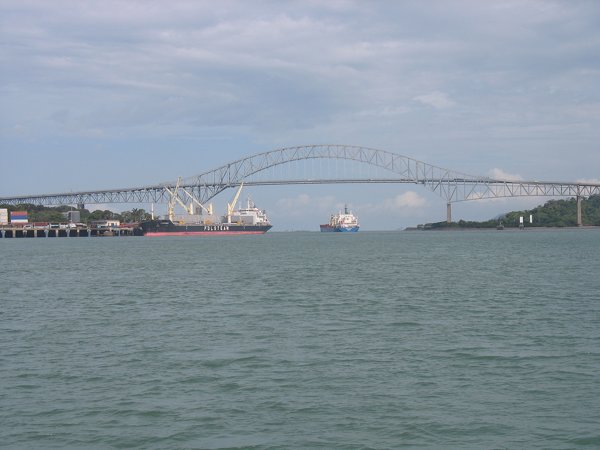
Bridge of the Americas with the Pacific
beyond.
At Balboa, we said goodbye to our line handlers and offloaded our
ropes and the tyres that had been used as fenders then went to the anchorage at
Las Brisas de Amador. The anchorage looks towards Panama City and the stunning amount of high
rise that is springing up. The boat looked as though we had thrown a party with
empty coca cola bottles, water bottles and Kentucky Fried barrels strewn about.
We decided to relax and leave it until tomorrow.
Panama City in the morning
haze.
The anchorage at Las Brisas de Amador. The
building that looks like a spider is a new museum/aquarium under
construction.
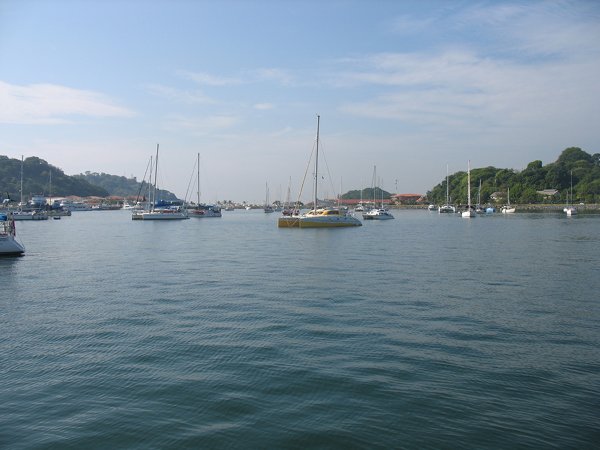
The anchorage at Las Brisas de Amador - this
is directly open to the Pacific Ocean. Generally it is calm like this; easy to
see why Balboa named it the Pacific
Ocean.
Convenient
roost.
Morning
visitor
A couple of days
later, Bob spent a very hot morning swapping seven old heavy marine batteries
for seven new ones. That afternoon, he started a serious attack on the
barnacles. It took a total of about four hours before he was satisfied that he
had cleared away enough. Unfortunately, a lot of our remaining anti-foul went
with them. Looks like a haul out and paint job in Polynesia. Hope we don’t pick up too much on the
way.
We also went
into Panama City
to provision before we set off into the Pacific. We were advised by an American
friend to stock up until we were falling over our provisions. Well Ed, we have
followed your advice. On Saturday, we came back with our final stock up in the
throws of a storm. The rain was so heavy that you could barely see the boats in
the anchorage. We waited for about an hour and a half and, when the rain had
eased to moderate, we set off. Bob had to bail the dinghy a couple of times
before we could get in. Luckily, the only item that we had that could be water
damaged was sugar. We managed to save 99% of that so it was just a matter of
drying everything off before it was stowed away. One of the pleasures of
boating! It’s not all sunny skies and drinks when the sun is over the yardarm.
Next stop –
Galapagos.
| 
